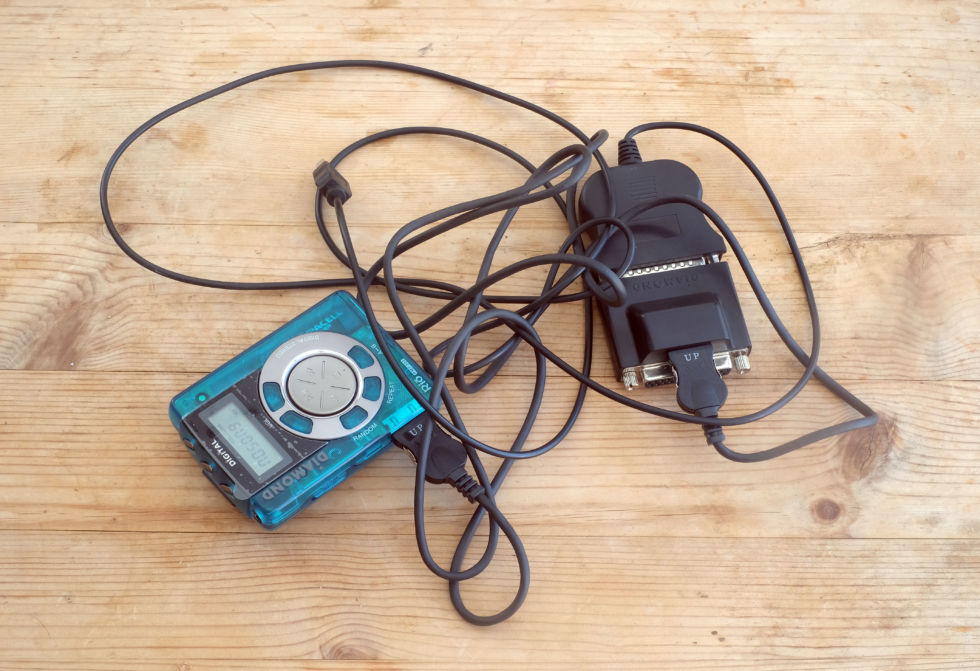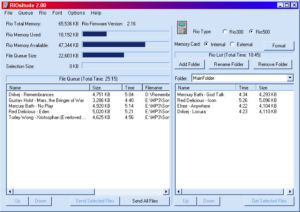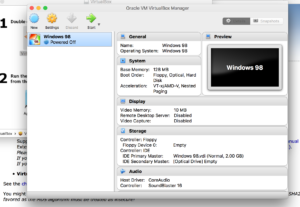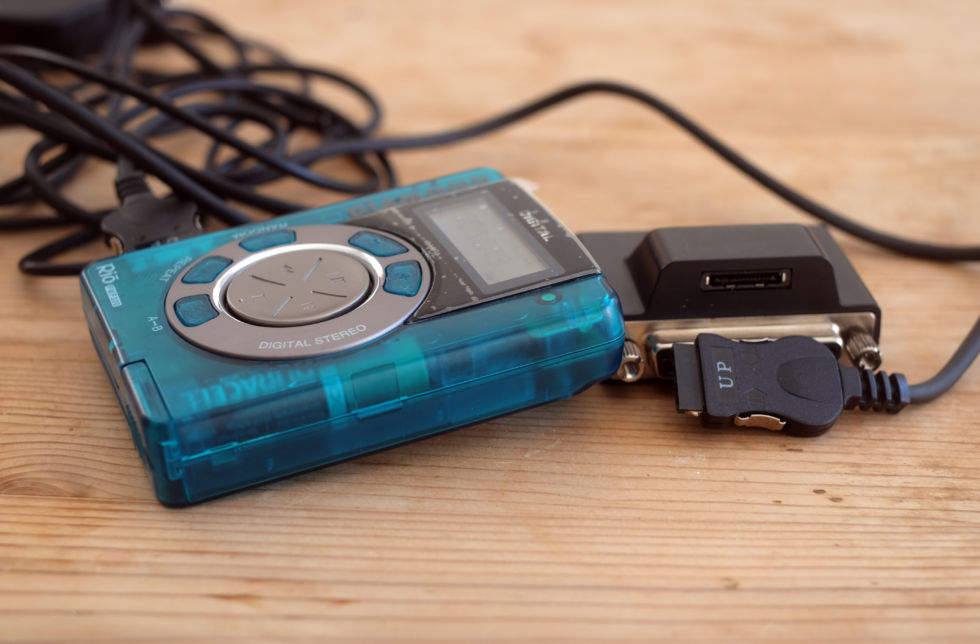The wonders of the Internet
I've got to hand it to the Internet; despite the age of the PMP300, I was still able to buy a brand-new, cellophane-intact device directly from a third-party seller on Amazon. Yes, the AA battery inside the box was a crystallised health hazard, but it was like opening a time capsule from another era. There are thick manuals, driver CDs, and ports most of us haven't touched for well over a decade. It seems odd that an MP3 player can seem more like an Encino Man now than a record turntable.
Looking every bit the precursor to Apple's first iPod, the PMP300 features buttons arranged in a circle below a display. There's volume up and down, a randomise button (great for randomising those six whole tracks you've transferred), a repeat button, a mysterious A/B button, and the usual play, skip, and stop buttons.
-
Inside the PMP300 box is a parallel port adaptor, the player itself, and a proprietary cable to connect them both together.
-
Reminder: this is how we used to live.
-
Like nearly every gadget in the late '90s, the PMP300 had an optional translucent finish.Andrew Williams
-
Inside is room for a single AA battery, which promised up to eight hours of playback.
My version is the "special edition," which comes with a luxurious 64MB of storage and a "translucent teal" casing showing off the toy-like circuit boards. But couldn't you imagine using this still? At 109g it’s lighter than most phones. And the chunky belt clip on the back makes it a prime target for hipster re-adoption. Curio quality aside, though, I actually wanted use this AA-powered, SmartMedia-card-packing relic. However, getting the darn thing to work became a stark reminder of just how easy we have it these days.
The Rio PMP300 was released in a time before USB. Mice and keyboards would use a PS/2 connector, while printers and other peripherals used great big 25-pin parallel ports. The PMP300 not only uses a parallel port adapter as chunky as the player itself, but also a proprietary cable. To lose it is to leave your PMP300 as a brick that'll only play The Prodigy's Fat Of The Land, or whatever else you might have loaded onto an MP3 player in 1998.
Basically, if you're complaining about how USB Type-C devices mean you have to buy a new £5 spare cable off of eBay, maybe it's time to check your privilege.
Kids today
My idea was to approach using the PMP300 like an entitled Windows 10 millennial—with zero preplanning. As none of my functioning computers had an on-board parallel port, a trip to Maplin was in order to hook the two devices up—and I emerged with the wrong cable. Ten years of tech journalism and a childhood of frustrated tinkering with config.sys files to make magazine floppy disk game demos work still wasn't enough for me to get it right first time.
Next stop: eBay, which we also didn't have the luxury of back in 1998. The auction site has been around since 1995, but even it didn't launch in the UK until 1999. The 90s are looking worse and worse, what with no iPhone, no eBay, probably no broadband, just lots and lots of parallel ports. Fulfilling its role as the best friend you kinda hate, the first parallel-port-to-USB cable I ordered from eBay was lost in the post. A mere three weeks later I had the re-ordered cable. Time to get started.



With weeks to spend tapping my fingers, I had done a bit of research by this point. Not only do the laptops and desktops I currently have access to lack the optical drive needed to install the driver CD, Rio didn't provide support for the PMP300 beyond Windows 98. This highlights a couple of 90s-era computing problems most of us have had the luxury of forgetting: the driver process is now so automatic it's effectively invisible, and these days you rarely see popular gadgets that sell hundreds of thousands of units see their support disappear almost as soon as the release buzz has died down. Windows 2000 arrived less than 18 months after the PMP300, but it isn't supported!
Just like today, though, what the big companies don't provide, the community does. A half-dozen projects to add PMP300 support for Windows XP and beyond have popped up over the years. RIOsitude is the main one, the work of Indie game developer Drilian, and it still works on Windows 10. Well, sort of. After trying all the compatibility modes Windows 10 has to offer, my Rio PMP300 still wasn’t being seen by the programme. What followed was a day of trying to get Windows to recognise the the player. I even started with an ancient laptop riddled with malware and whose dodgy display connection left the bottom inch of the screen a distorted mess, the start bar obscured. Still no joy.
Next up I tried going native with a virtual Windows 98 machine running on a MacBook using Oracle VM VirtualBox, dumping the PMP300 right onto home turf. But when even trying to get USB drivers to work caused Windows 98 to hang at the logo screen, I decided to sack the whole endeavour off and go for a run to sweat out the stress of those late 90s tech headache flashbacks.
We’ve never had it so good
The root of the problem highlights how our relationships with our computers have changed in the last 20 years. Windows couldn't see the Rio PMP300 because the software wasn't just looking for the player, it was looking for the player exclusively on the LPT1 parallel port. Windows 10 is designed to let its users be virtually clueless and get on just fine nonetheless. Windows versions of old were not nearly so idiot-proof, much as Microsoft might have tried to sell us that exact idea way back when.
If you're old enough to remember using an OS as ancient as Windows 98, Windows 95, or even Windows 3.1, you may remember fixing problems felt like tinkering with a machine. Afternoons wasted fiddling with a BIOS or config files were annoyingly common, and with each little tweak you'd restart the system and pray not to witness the blue screen of death. It was the kind of fail-fail-fail-win gratification people play masochistic games like Dark Souls III for today.

The extra intelligence of today's systems wipes out much of that struggle, which might explain why the idea of making an app with Unity or learning to code with a Raspberry Pi scratches that tech itch instead.
For all those years I spent getting good at past versions of Windows, the Rio PMP300 is still in front of me right now, mocking me with its "NOSONG" taunt. It's not over yet, though. All I need is another trip to eBay for a SmartMedia card, a 128Kbps-rip of Fat Of The Land, and a few forum secrets on how Rio's arcane file system works, and I think I'll have a solid 45 percent chance of getting this little guy working. See you in a month.
Andrew Williams is a freelance technology journalist who has been writing in the field for 10 years. He covers just about all areas of consumer tech, with a particular interest in how it all works underneath the layers of glossy finish and impressive-sounding jargon. He can be found on Twitter at @wwwdotandrew.
reader comments
213